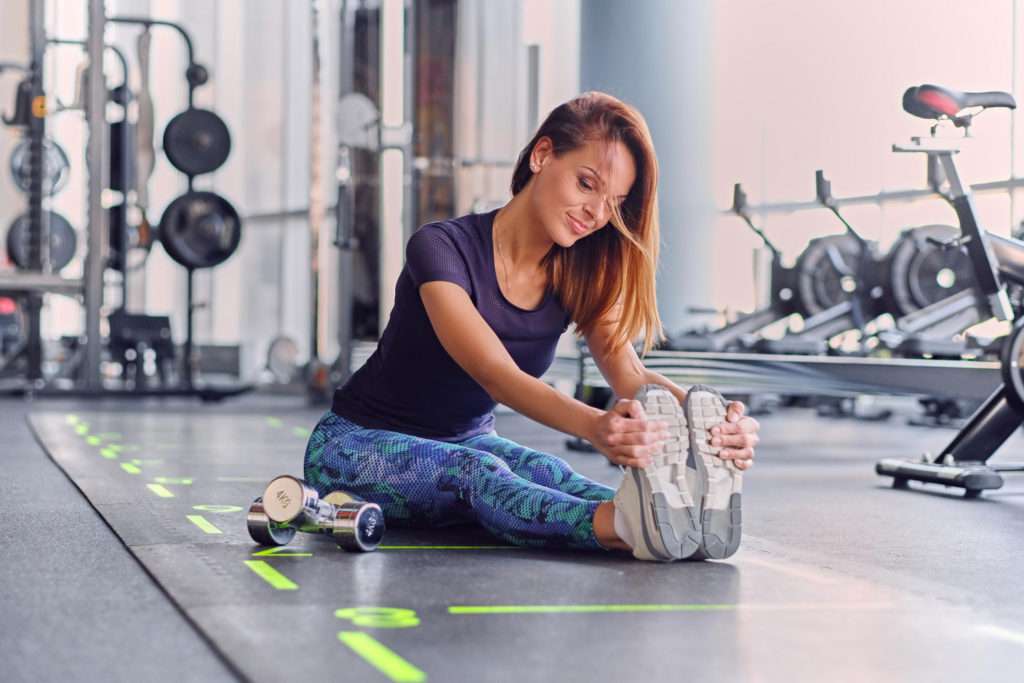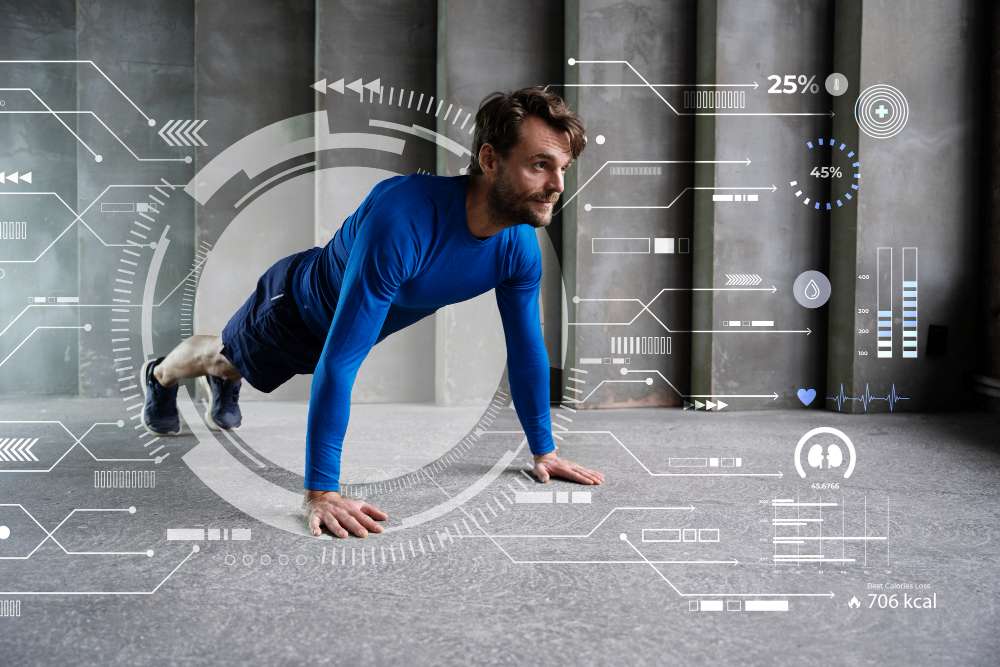Physical and mental health are two essential aspects of our well-being. They are closely intertwined and affect each other in various ways. For example, physical activity can improve mood, reduce stress, enhance cognitive function, and prevent chronic diseases. On the other hand, mental health can influence motivation, self-esteem, energy levels, and resilience. Therefore, it is important to take care of both our body and mind for optimal health and happiness.
However, maintaining a regular and effective exercise routine can be challenging for many people. Some of the common barriers include lack of time, access, resources, guidance, and motivation. Moreover, traditional exercise methods may not suit everyone’s needs, preferences, and goals. This is where artificial intelligence (AI) comes in. AI is a branch of computer science that aims to create machines and systems that can perform tasks that normally require human intelligence, such as learning, reasoning, and decision making. AI has the potential to revolutionize the way we exercise and improve our physical and mental health.

In this article, we will explore how AI can enhance our exercise experience, support our mental health, and overcome some of the challenges and concerns associated with AI-powered fitness technology. We will also look at some of the success stories and case studies of individuals who have benefited from AI-powered exercise programs, as well as the future prospects and possibilities of AI in the fitness industry. By the end of this article, you will have a better understanding of how AI can help you optimize your health and well-being.
The Link Between Physical and Mental Health
Before we dive into how AI can improve our exercise and health, let us first understand the link between physical and mental health. As mentioned earlier, physical and mental health are interrelated and influence each other in various ways. Research has shown that physical activity can have positive effects on mental health, such as:
- Improving mood and reducing depression and anxiety. Exercise can stimulate the release of endorphins, serotonin, and dopamine, which are neurotransmitters that regulate mood and emotions. Exercise can also provide a sense of accomplishment, enjoyment, and social interaction, which can boost self-esteem and confidence.
- Reducing stress and enhancing coping skills. Exercise can help lower cortisol levels, which is a hormone that is associated with stress and inflammation. Exercise can also provide a distraction from negative thoughts and feelings, as well as a way to channel and release pent-up emotions. Furthermore, exercise can improve resilience and adaptability, which can help us cope with challenging situations and events.
- Enhancing cognitive function and preventing cognitive decline. Exercise can improve blood flow and oxygen delivery to the brain, which can enhance brain function and neuroplasticity. Exercise can also stimulate the growth of new brain cells and connections, which can improve memory, learning, and creativity. Additionally, exercise can prevent or delay the onset of neurodegenerative diseases, such as Alzheimer’s and Parkinson’s, by protecting the brain from damage and inflammation.

On the other hand, mental health can also affect physical health, such as:
- Influencing motivation and behavior. Mental health can affect our willingness and ability to engage in physical activity. For example, depression and anxiety can reduce motivation, energy, and interest in exercise. Conversely, positive emotions and attitudes can increase motivation, enthusiasm, and persistence in exercise.
- Affecting physical performance and outcomes. Mental health can affect our physical performance and results. For example, stress and anxiety can impair concentration, coordination, and reaction time, which can affect our skill and efficiency in exercise. Conversely, confidence and optimism can enhance performance and outcomes, by increasing focus, determination, and self-efficacy in exercise.
- Impacting physical health and well-being. Mental health can affect our physical health and well-being. For example, chronic stress and depression can weaken the immune system, increase inflammation, and increase the risk of cardiovascular diseases, diabetes, and obesity. Conversely, happiness and well-being can strengthen the immune system, reduce inflammation, and lower the risk of chronic diseases.
Therefore, it is clear that physical and mental health are closely linked and mutually beneficial. By exercising regularly and effectively, we can improve both our physical and mental health, and vice versa. However, as we will see in the next section, traditional exercise methods may not be sufficient or suitable for everyone. This is where AI can offer a better alternative and solution.
Traditional Exercise vs. AI-Powered Exercise
Traditional exercise methods refer to the conventional ways of exercising, such as going to the gym, joining a fitness class, following a workout video, or using a fitness app. These methods have their advantages and disadvantages, depending on the individual’s needs, preferences, and goals. Some of the benefits of traditional exercise methods include:
- Accessibility and affordability. Traditional exercise methods are widely available and affordable for most people. For example, going to the gym or joining a fitness class can provide access to various equipment, facilities, and instructors. Alternatively, following a workout video or using a fitness app can be done at home or anywhere, with minimal or no cost.
- Structure and guidance. Traditional exercise methods can provide structure and guidance for people who are new to exercise or need some direction. For example, going to the gym or joining a fitness class can offer a predefined workout plan and schedule, as well as professional supervision and feedback. Similarly, following a workout video or using a fitness app can offer a step-by-step instruction and demonstration, as well as tips and advice.
- Variety and fun. Traditional exercise methods can provide variety and fun for people who are bored or unmotivated by exercise. For example, going to the gym or joining a fitness class can offer different types of exercises, such as cardio, strength, flexibility, and balance. Likewise, following a workout video or using a fitness app can offer different themes, styles, and levels of exercises, such as yoga, dance, HIIT, and Pilates.
However, traditional exercise methods also have their limitations and drawbacks, such as:
- Lack of personalization and customization. Traditional exercise methods may not be personalized or customized to the individual’s needs, preferences, and goals. For example, going to the gym or joining a fitness class may not take into account the individual’s fitness level, health condition, injury history, or personal objectives. Similarly, following a workout video or using a fitness app may not consider the individual’s availability, equipment, environment, or feedback.
- Lack of accuracy and effectiveness. Traditional exercise methods may not be accurate or effective in measuring and improving the individual’s performance and outcomes. For example, going to the gym or joining a fitness class may not provide accurate or timely data on the individual’s heart rate, calories burned, distance covered, or progress made. Likewise, following a workout video or using a fitness app may not provide reliable or relevant feedback on the individual’s form, technique, intensity, or improvement.
- Lack of motivation and support. Traditional exercise methods may not provide enough motivation and support for the individual to stick to and enjoy exercise. For example, going to the gym or joining a fitness class may not provide enough encouragement, recognition, or reward for the individual’s efforts and achievements. Similarly, following a workout video or using a fitness app may not provide enough interaction, communication, or connection with the instructor or other participants.
This is where AI-powered exercise solutions can offer a better alternative and solution. AI-powered exercise solutions refer to the innovative ways of exercising that use AI technology, such as machine learning, computer vision, natural language processing, and speech recognition. These solutions can provide personalized, accurate, and motivating exercise experiences, such as:
- Personalized workout routines tailored to individual needs and goals. AI-powered exercise solutions can create customized workout routines that suit the individual’s fitness level, health condition, injury history, and personal objectives. For example, AI can analyze the individual’s biometric data, such as heart rate, blood pressure, and body fat percentage, and design a workout plan that optimizes the individual’s health and well-being. AI can also adapt the workout plan according to the individual’s feedback, preferences, and progress, and provide recommendations and suggestions for improvement.
- Real-time feedback and analysis for improved performance. AI-powered exercise solutions can provide real-time feedback and analysis on the individual’s performance and outcomes. For example, AI can use computer vision and sensors to monitor and track the individual’s movements, posture, and form, and provide instant and accurate feedback on how to correct and improve them. AI can also use machine learning and data analytics to measure and evaluate the individual’s results, such as calories burned, distance covered, and progress made, and provide insights and reports on how to enhance them.
- Virtual trainers and fitness assistants for motivation and guidance. AI-powered exercise solutions can provide virtual trainers and fitness assistants that can motivate and guide the individual throughout the exercise session. For example, AI can use natural language processing and speech recognition to create conversational agents that can interact and communicate with the individual in a natural and human-like way. AI can also use gamification and social features to create engaging and fun exercise experiences that can increase the individual’s enjoyment, satisfaction, and retention.
Therefore, it is evident that AI-powered exercise solutions can offer many benefits and advantages over traditional exercise methods. By using AI technology, we can create more personalized, accurate, and motivating exercise experiences that can improve our physical and mental health. In the next section, we will explore how AI can specifically enhance our physical exercise and support our mental health.
How AI Enhances Physical Exercise
Physical exercise is one of the most effective ways to improve our physical health and well-being. It can help us prevent or manage various chronic diseases, such as cardiovascular diseases, diabetes, obesity, and cancer. It can also help us improve our fitness, strength, endurance, flexibility, and balance. However, not all exercises are created equal. Depending on our needs, preferences, and goals, we may need different types of exercises, such as aerobic, anaerobic, resistance, or functional. Moreover, we may need different levels of intensity, duration, frequency, and progression for our exercises, depending on our fitness level, health condition, injury history, and personal objectives.
This is where AI can enhance our physical exercise by providing personalized, accurate, and effective workout routines that suit our individual needs and goals. AI can use various data sources, such as biometric sensors, wearable devices, smart scales, and fitness apps, to collect and analyze our physical data, such as heart rate, blood pressure, body fat percentage, weight, height, and BMI. AI can also use questionnaires, surveys, and feedback to gather and understand our preferences, interests, and goals, such as the type of exercise we like, the time and place we want to exercise, and the results we want to achieve.
Based on these data, AI can create customized workout routines that optimize our health and well-being. AI can also adapt these workout routines according to our feedback, preferences, and progress, and provide recommendations and suggestions for improvement. For example, AI can:
Adjust the intensity, duration, frequency, and progression of our exercises. AI can monitor and track our performance and outcomes, such as calories burned, distance covered, and progress made, and adjust the difficulty and complexity of our exercises accordingly. AI can also use machine learning and data analytics to measure and evaluate our results, such as fitness level, health condition, and personal objectives, and adjust the goals and expectations of our exercises accordingly.
Recommend the best type of exercise for our needs and goals. AI can use natural language processing and speech recognition to understand our needs and goals, such as losing weight, gaining muscle, improving flexibility, or reducing stress, and recommend the best type of exercise for us. AI can also use computer vision and sensors to detect and analyze our movements, posture, and form, and recommend the best exercise for us.
Create diverse and fun exercise experiences. AI can use gamification and social features to create engaging and fun exercise experiences that can increase our enjoyment, satisfaction, and retention. For example, AI can create virtual reality and augmented reality environments that can immerse us in different scenarios and challenges, such as running in a forest, climbing a mountain, or fighting a zombie. AI can also create social networks and communities that can connect us with other people who share our interests and goals, and provide support, encouragement, and competition.
Therefore, it is clear that AI can enhance our physical exercise by providing personalized, accurate, and effective workout routines that suit our individual needs and goals. By using AI technology, we can improve our physical health and well-being, and achieve our fitness goals faster and easier. In the next section, we will explore how AI can support our mental health by integrating mindfulness and meditation practices into our workout routines.
Further Reading
- Why AI In Healthcare Is Critical To Improve Mental Health And Wellness
- Artificial intelligence in healthcare: transforming the practice of medicine
- AI Companions: The Next Frontier of Human Interaction
- How AI is Revolutionizing Healthcare by Analyzing the Gut Microbiome and Its Impact on Mental Health
